Win Badminton Rallies in Badminton Singles: Tips and Strategies
Badminton singles is the most challenging discipline in badminton. It truly tests your physical and mental strength.
Physical Fitness
In terms of physical requirements, a singles game requires you to move quickly around the badminton court to retrieve the shuttle.
You’ll need high level of fitness to play a successful game of badminton.
Mental Strength
Besides physical strength, badminton singles players also need to have strong mental fitness.
Unlike a doubles game, a singles player will be playing ALONE on the court. As such, you’ll need to have strong mental fitness to get you through your game.
Confidence plays an important role in a singles game. In many instances, during a singles game, a younger or inexperienced player may lack the confidence in winning rallies.
This happens especially when playing with new opponents or when the player is playing in an intense competition or tournament.
Therefore in order to win a singles game, a player needs to keep his/her level of confidence high at all times during the game.
Basic Singles Rules
A badminton rally is started when a player performs the badminton serve.
Upon performing the service, the player will need to serve to the service boundaries.
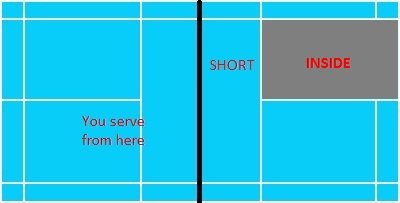
The picture above shows you the in/out boundaries for a badminton service in a singles game.
Upon making a service in a singles game, you’ll need to serve to the grey area as indicated in the picture above. It will be deemed OUT if it lands anywhere else.
After the service has been delivered, the badminton rally commences.
During the rally, you’ll need to hit the shuttle within the singles in/out boundaries.

The picture above shows you the in/out boundaries for a badminton singles game.
When the rally is in play, you’ll need to keep the shuttle inside the yellow area in the picture above. It will be OUT if it lands anywhere else.
Click here if you want to read more on badminton rules.
How to Win Rallies in Badminton Singles
In badminton singles, the basic strategy is to attempt to prolong or delay the rally, then play the winning shot only when you get a clear chance.
The winning shot is usually referred to as the badminton smash, where you hit the shuttle downwards and steeply towards your opponent’s side.
Badminton is a game of speed and power. A Badminton Singles game is more about speed instead of power.
In order to outplay your opponent, you’ll need to have the speed (to move around the court) in order to play your game at a higher pace.
The player who is able to play at a higher pace/tempo will eventually have the advantage to win badminton rallies.
Basic Shots
There are a few of basic badminton shots you can use accordingly to the situation.
1. Badminton Clear/Lob
Badminton Overhead Clear Trajectory
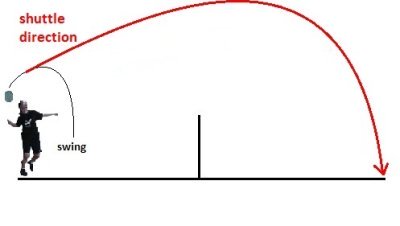
Badminton Underarm Clear Trajectory
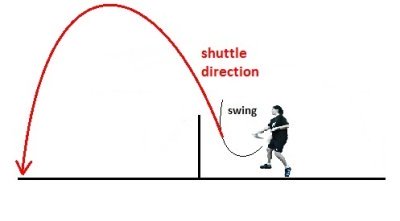
A clear or lob can be performed using an overhead or underarm stroke. The clear is mainly used to get you out of trouble!
The badminton clear gives more time to the player to get back into position and reorganize his footwork.
When you realise that your opponent is playing at a much faster pace than you, hit a high clear.
This slows the tempo of the game, hence buying yourself some time to get yourself back into the rally.
Otherwise, your opponent can easily attack you ‘off-guard’. You’ll find yourself having trouble defending.
You’ll realise that more clears and lobs are performed in a singles game, as compared to doubles.
This is because singles players often get themselves out of their footwork base (centre of the court). By performing the high clear, they have time to get themselves back into the rally.
Click here for the tutorial on badminton clear.
2. Badminton Drop Shot
Badminton Drop Shot Trajectory
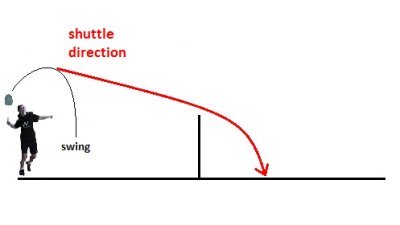
A drop shot is a very good weapon to keep the tempo of the game going.
The drop shot is performed when your opponent clears/lob the shuttle to you.
If you think you’re not in a position to hit the winning shot (smash), or if you think that your smash will not win a rally (or at least test your opponent), HIT the DROP SHOT.
Therefore, hit the drop shot when
- You are playing faster or at the same pace as your opponent.
- You think that you are not ready to put the rally away with a smash.
Click here for the tutorial on the badminton drop shot.
3. Badminton Smash
The badminton smash is often the winning shot in badminton.
Badminton Smash Trajectory:
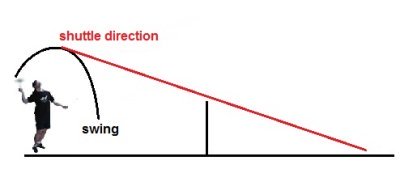
However, the smash is a risky shot.
It’s risky because after you smash, you’ll need to maintain good balance. You need to be quick enough to return to your footwork base (right in the middle of the court).
If you don’t do this, you’ll find yourself in trouble if your opponent manages to retrieve your smash.
Therefore, it’s important to be sure that your smash will end the rally (or at least force a weak return).
Hit the smash ONLY at the right opportunity. An opportunity arises when:
- You get a high clear/lob/lift from your opponent.
- You manage to get your opponent out of position
- You are ready to smash. In other words, you’re able to get behind the shuttle in time and have good balance.
- Your smash will catch your opponent off-guard.
Click here for the tutorial on badminton smash.
Remember, do not rush or panic. Play smart so that you can outplay your opponent.
Wait for your chance to smash. Delay rallies to force an error out of your opponent.
Simple Badminton Singles Strategy
Here is the simplest strategy employed in every singles game. You’ll want to force a high clear/lift from your opponent so that you can execute the winning smash.
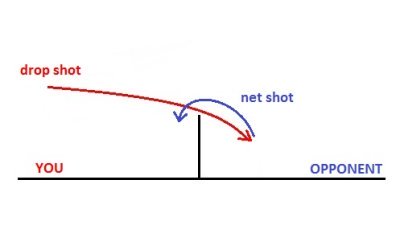
Step 1: Force your opponent to the net area (usually with a drop shot).
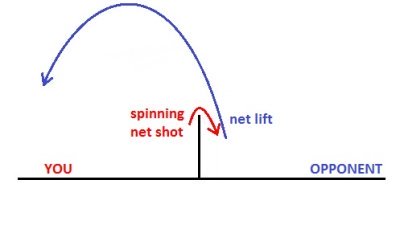
Step 2: Engage in net play. You should learn basic badminton net shots so that you are able to play a spinning net shot.
A tight spinning net shot often forces your opponent to lift the shuttle high up to you. If the net shot is so good, your opponent’s lift will more likely end up at half court.
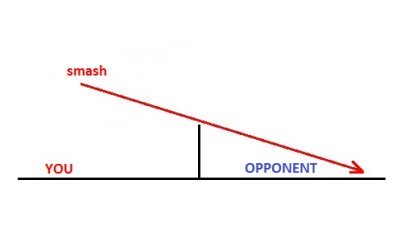
Step 3: Play the winning shot (smash!) and put the rally away.
Return from Badminton Singles to Badminton Tips
Please Like me on Facebook. Thanks!

Tell me what you think!
What do you think about what you just read? Leave me a comment below.
>